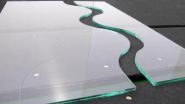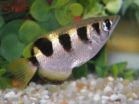(Press-News.org) If an object slams into the glass façade of a high-rise building, the glass must not shatter and fall down, because it could harm pedestrians below. In addition, the window panes must hold if a person were to fall against it from the inside. Architects and builders therefore must use something stronger than laminated safety glass on the façades of high rise buildings. The same applies to the windshields on cars. Safety glass prevents passengers in an accident from getting hurt by glass shards. And shop windows made of safety glass are expected to reliably safeguard the displayed goods from thieves. The principle behind this glass: a tear-proof film is inserted between two panes of glass, thus making the glass shock resistant. If glass fragments arise, they stay attached to the film. Safety glass panes are produced in panels measuring 6 x 3.20 meters, which are subsequently cut-to-size as required. Since the inserted film is tear-proof, the glass pane cannot simply be cut apart. First, both glass panes encasing the film are carved and fractured. Then, the break line is heated with an infrared heating element. The heat softens the film, and the halves are forcibly pulled apart until a knife can be guided through the gap. But this method has a drawback: It only allows for straight-line cuts.
If architects want extravagantly shaped windows, like round ones, the standard practice is for the safety glass panes to be carved and detached by hand. However, the resulting gap is too small to allow enough space for a knife, which could also inadvertently sever the film. To widen the gap, and ultimately to be able to cut the desired form, the film is softened with heat by applying alcohol and setting it alight. A new method will soon be able to circumvent this dangerous procedure. Researchers at the Fraunhofer Institute for Mechanics of Materials IWM in Freiburg, working jointly with Hegla, have engineered a new process. "We cut the interior film before the glass is scored and broken apart," explains Tobias Rist, scientist at Fraunhofer IWM. "We use a laser beam that can be guided over the pane as desired. This is why we are also able to cut unusual geometries." The laser beam penetrates the glass and releases its energy primarily in the film. The film gets hot enough for it to melt and vaporize. With this method a channel is produced in the film, and the film is separated locally. When the film is "cut," the glass is carved and fractured parallel to the resulting film channel. "The process can be readily automated and applied on an industrial scale," says Rist.
Researchers will exhibit safety glass that features an undulating dividing line at the Glasstec trade fair from 23 to 26 October in Düsseldorf (Hall 15, Booth E25). The laser process is operationally ready; Hegla will integrate it into a new laminated safety-glass pattern cutting system, and optimize it for industrial use. Hegla has already been granted a German and a European patent for the process of carving contours. The researchers are now working on another step that will make the process even faster, thereby increasing clock speed.
INFORMATION:
Safety glass - cut to any shape
2012-10-25
ELSE PRESS RELEASES FROM THIS DATE:
"Spoon River Revisited" by Daniel J. Benor, MD: Messages From the Spirits - Halloween Launch From Wholistic Healing Publications
2012-10-25
One man's death is a tragedy; a million is a statistic. - Joseph Stalin
This book of prose poems is a captivating visit to the legendary town of Spoon River, viewed through the epitaphs of its residents. SPOON RIVER REVISITED is an insightful sequel to Edgar Lee Master's 1916 classic, Spoon River Anthology. The people who share their modern stories still struggle with challenges of growing up, making their way through life, and passing on.
Death has an undeserved, bad reputation! Within the understandings of western medicine, when the body stops working, that is ...
Timing is everything: Hormone use may reduce or increase Alzheimer's disease risk in women
2012-10-25
MINNEAPOLIS – A new study suggests that women who begin taking hormone therapy within five years of menopause may reduce their risk of developing Alzheimer's disease. The research is published in the October 24, 2012, online issue of Neurology®, the medical journal of the American Academy of Neurology.
"This has been an area of debate because observational studies have shown a reduced risk of Alzheimer's disease with hormone therapy use, while a randomized controlled trial showed an increased risk. Our results suggest that there may be a critical window near menopause ...
Nearly 80 million Americans won't need vitamin D supplements under new guidelines
2012-10-25
MAYWOOD, Ill. - Nearly 80 million Americans would no longer need to take vitamin D supplements under new Institute of Medicine guidelines, according to a study by Loyola University Chicago Stritch School of Medicine researchers.
Results were published Oct. 24, 2012 in the journal PLOS ONE.
The new guidelines advise that almost all people get sufficient vitamin D when their blood levels are at or above 20 nanograms per milliliter (ng/ml). Older guidelines said people needed vitamin D levels above 30 ng/ml.
Holly Kramer, MD, MPH and colleagues examined data from 15,099 ...
Genome analysis of pancreas tumors reveals new pathway
2012-10-25
HOUSTON -- (October 24, 2012) – , said a Baylor College of Medicine physician-scientist who was part of the local team that took part in the international effort. A report appears online in the journal Nature.
"We now know every gene involved in pancreatic cancer," said Dr. William Fisher, professor of surgery and director of the Elkins Pancreas Center at BCM. "This study ushers in a whole new era of taking care of patients with pancreatic cancer. We will look back on this as a turning point in understanding and treating this disease."
The study follows a five-year ...
Advanced cancer patients overoptimistic about chemotherapy's ability to cure, study finds
2012-10-25
BOSTON––Findings from a nationwide study led by researchers at Dana-Farber Cancer Institute suggest that patients with advanced lung or colorectal cancer are frequently mistaken in their beliefs that chemotherapy can cure their disease.
The study, published in the Oct. 25 issue of the New England Journal of Medicine, found that 69 percent of patients with advanced lung cancer and 81 percent of patients with advanced colorectal cancer did not understand that the chemotherapy they were receiving was not at all likely to cure their disease. Their expectations run counter ...
Future training in bystander CPR needs targeted approach in 'high-risk' neighborhoods
2012-10-25
Residents living in high-income white and high-income integrated neighborhoods were more likely to receive bystander CPR (cardiopulmonary resuscitation) during an out-of-hospital cardiac arrest than arrest victims in low-income black neighborhoods, according to a publication in the Oct. 25 issue of the New England Journal of Medicine (NEJM). Arrest victims in low-income white, low-income integrated and high-income black neighborhoods were also less likely to receive bystander CPR.
In an effort to look at future CPR training processes and public health planning, researchers ...
Prescription for palliative care: 4 points to improve discussions about dying
2012-10-25
In an editorial appearing in the October 25 issue of The New England Journal of Medicine, medical oncologists at Johns Hopkins and Brigham and Women's hospitals provide a four-point plan for integrating palliative care discussions throughout the treatment of patients with terminal illnesses. They write that better planning and communication may improve symptoms, stress, and survival time, as well as lower health care costs at the end of life.
The two physicians suggest that their colleagues should discuss palliative care with patients during initial talks about prognosis ...
Gaps in border controls are related to alien insect invasions in Europe
2012-10-25
European countries with gaps in border security surrounding agricultural imports have been invaded by the largest number of exotic insect pests, according to research published Oct 24 in the open access journal PLOS ONE by Steven Bacon and colleagues from the Swiss Federal Research Station Agroscope ART and the University of Fribourg, Switzerland.
Invasive agricultural pests pose growing environmental and economic problems, threatening biodiversity and costing billions of dollars in economic losses annually. Large volumes of cross-border trade increase the risks of invasion, ...
OHSU researchers test new gene therapy method in human cells... and it works
2012-10-25
PORTLAND, Ore. - Oregon Health & Science University's development of a new gene therapy method to prevent certain inherited diseases has reached a significant milestone. Researchers at the university's Oregon National Primate Research Center and the OHSU Department of Obstetrics & Gynecology have successfully demonstrated their procedure in human cells. It's believed that this research, along with other efforts, will pave the way for future clinical trials in human subjects.
The research results are online Wednesday, Oct. 24, in the highly respected journal Nature. Dr. ...
Archer fish hunt insects with water jet 6 times stronger than their muscular power
2012-10-25
Archer fish knock their insect prey out of overhanging vegetation with a jet of water several times more powerful than the fish's muscles. New research now shows that the fish generate this power externally using water dynamics rather than with any specialized internal organs. The research, published Oct. 24 in the open access journal PLOS ONE by Alberto Vailati and colleagues from the University of Milan, provides the first explanation for how archer fish can generate such powerful jets to capture their prey.
Other animals like chameleons and salamanders store energy ...


